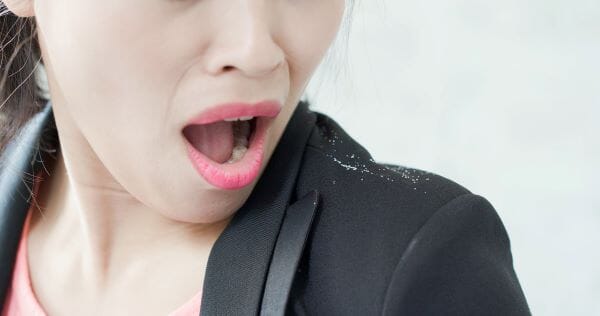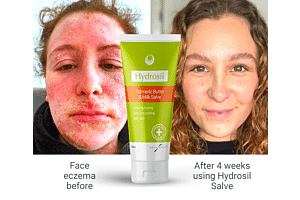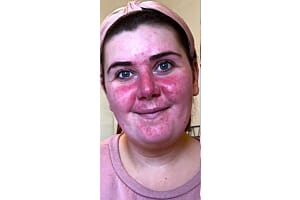Not all dandruff is formed equal. Although dandruff may just appear as a flaky scalp to the naked eye, in fact types of dandruff and what causes it can differ widely as can the best treatments for it.
Here consultant dermatologist Dr Eva Melegh identifies 7 different types of dandruff and what your scalp flakes tells you about your health;
1. Large waxy flakes - scalp fungus
A lot of dandruff is caused by a fungus called Malassezia globose that feeds off the oils on our skin and hair. It produces oleic acid, which can irritate our skin. In some people, this sets off an immune response which can lead to a rapid turnover of skin cells that is what produces fungal dandruff.
Flake state
Large waxy flakes, often appear with greasier hair.
Scalp solution
Anti dandruff shampoos containing pyrithione zinc which is the most common anti-fungal ingredient. However over use of anti-dandruff shampoos can lead to a dry and sensitive scalp and cause different sort or dandruff so their use should be limited.
2. Small dry white flakes, with tight scalp and itching – scalp allergy
Studies show that around 10% of the population suffer from an allergy to a common preservative used in most standard shampoos called MITT (Methylisothiazolinone). In addition, allergies to perfumes and detergents in shampoos and can also trigger scalp allergies. Over-use of anti-dandruff shampoos for fungal dandruff can lead to dry scalp dandruff instead.
Flake State
Small dry and white flakes with an itchy tight feeling scalp that is often worse soon after washing hair.
Scalp Solution
Chemical-free and reparative scalp treatments to reduce irritation, improve scalp moisturisation and repair Skin Barrier Function through the use of prebiotic ingredients. Try Hydrosil Scalp Shield Tonic.
3. Fine dry white flakes without itching – burned scalp
While we all slather on the sun cream, few of use realise how exposed and sensitive the scalp is to UV damage. Sunburn to the scalp is very common, especially if you have thin hair, and even hot water from the shower can mildly burn the scalp. So if you have been out in the sunshine at the weekend or on holiday or have been turning up the heat in the shower and a week later you have a flaky scalp, chances are you may have burned your scalp.
Flake State
Fine white flakes and tight feeling scalp
Scalp Solution
Highly moisturising shampoos without perfumes and leave-in scalp serums for improved scalp conditioning. Stick to tepid showers and wear a hat during sunlight hours until things improve.
4. Yellow flakes on scalp, eyebrows (beard) with inflamed scalp - scalp eczema
Seborrheic dermatitis is an underlying inflammatory skin condition caused by damaged skin barrier function moisture loss and then usually secondary bacterial infection form the oil of the hair follicles. It’s likely that patches of eczema will be present on other areas of the body, most likely the cracks of the arms and knees and behind the knees, although sometimes it can appear just on the scalp.
Flake State
Yellowish coloured flakes that appear in the hair (more concentrated around the hair line) eyebrows and other facial hair with underlying scalp or skin redness, blistering and itching. Often accompanied by a greasier scalp and hair.
Scalp Solution
A prescribed mild corticosteroid scalp wash can calm the inflammation though corticosteroids are not suitable for use over long periods. As a preventative for daily use to use in use a chemical free, perfume-free and scalp cleansing shampoo that helps repair skin barrier function. Try Hydrosil Scalp Shield Shampoo with prebiotics for scalp barrier repair.
Avoid any sticky or perfumed hair products.
5. Small white flakes with hair loss – vitamin deficiency
Iron, copper and zinc deficiencies as well as a lack of essential fatty acids, often as a result of low-calories weight loss diets, can cause your scalp to flake and hair loss.
Flake State
Small fine white flakes with increased and sudden hair loss
Scalp Solution
Vitamin B12, biotin, zinc and omega fatty acids supplements. Try The Ordinary Multi-Peptide Serum for Hair Density.
6. Large silvery flakes with grey & red scaling on scalp and hairline– scalp psoriasis
Scalp psoriasis is one of the most common places for psoriasis to appear first and is often mistaken for normal dandruff.
Psoriasis affects around 2% of the UK population. It is caused by an acceleration of skin cell production. Normally a skin cell matures in 21-28 days. Psoriatic cells, however, turn over in 2-3 days and in such profusion that the live cells reach the surface and accumulate with the dead cells still in visible plaques.
Flake State
Large silvery flakes with red and greyish round skin plaques on the scalp
Scalp Solution
Coal tar shampoos are commonly prescribed for treating scalp psoriasis but are messy, smelly and not particularly effective. Instead try Oregon Shampoo & Conditioner, two hair care products developed by a UK trichologist and trialled at Bath University for use on scalps prone to psoriasis. 95% of users on the trial found that Oregon hair care products improved itching and dryness and softened and reduced scalp plaques. These are designed to recue plaque build-up without irritation or dryness and are low-odour.
7. Greasy small yellowy flakes with spots on the scalp – scalp acne (folliculitis)
Scalp acne occurs when hair follicles become blocked with oil and dead skin cells, or bacteria, and subsequently become inflamed or infected. Hormonal changes such as puberty, pregnancy and menstruation can be a trigger for scalp acne. In addition, sticky or pore clogging hair products like gels and hair sprays can also add to the problem.
Flake State
Greasy yellowy flakes with spots or cysts on the scalp
Scalp Solution
Prescription medicated shampoos normally containing salicylic acid and or glycolic acid can help treat the problem or in more severe cases benzoyl peroxide. Shampoos or scalp tonics containing tea tree oil or birch water can also help as preventatives for everyday use.












